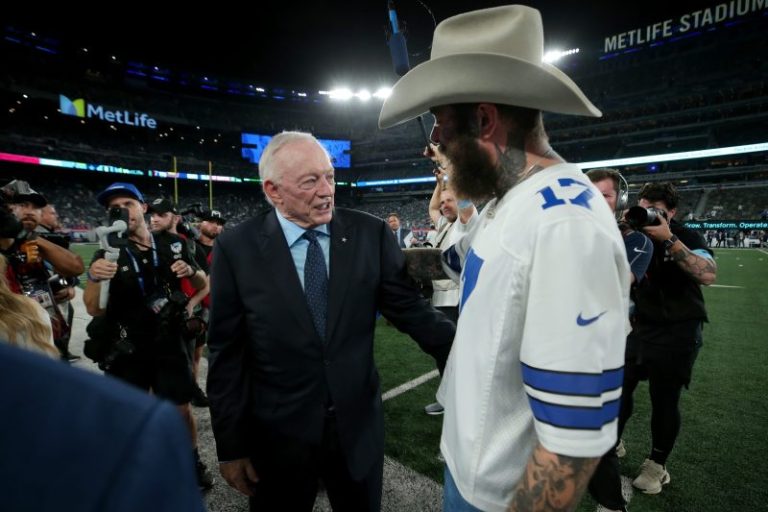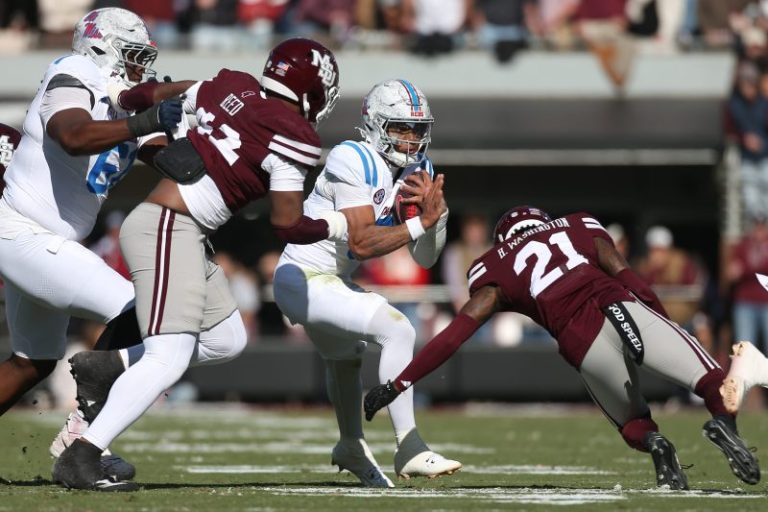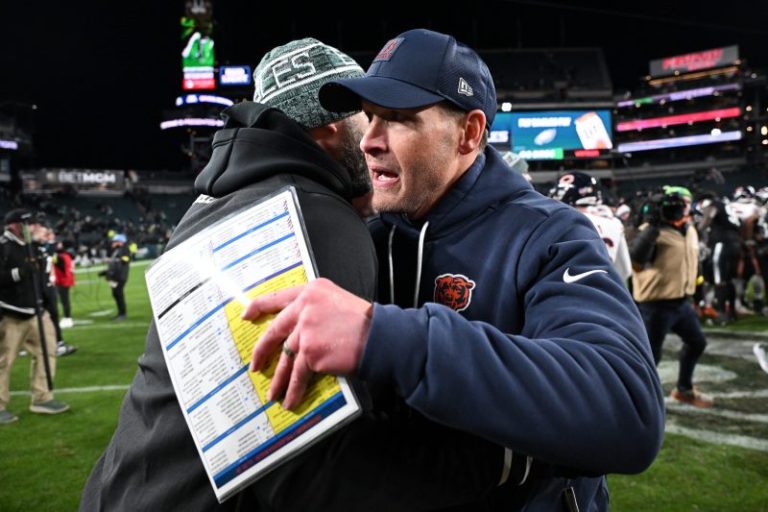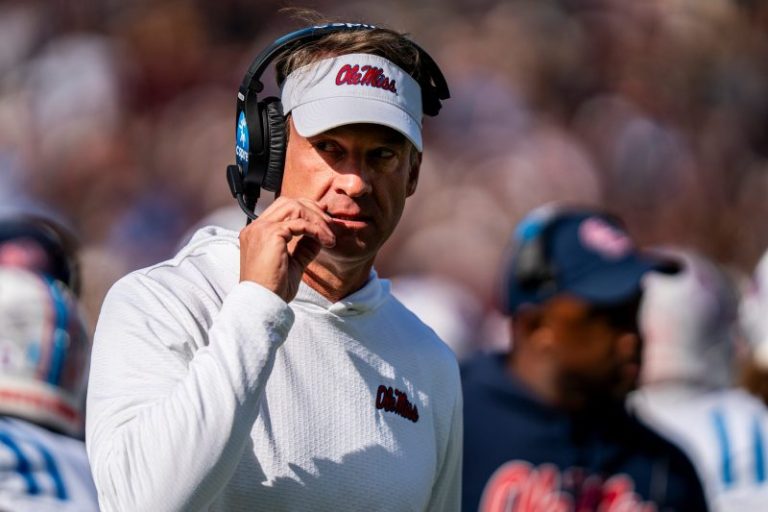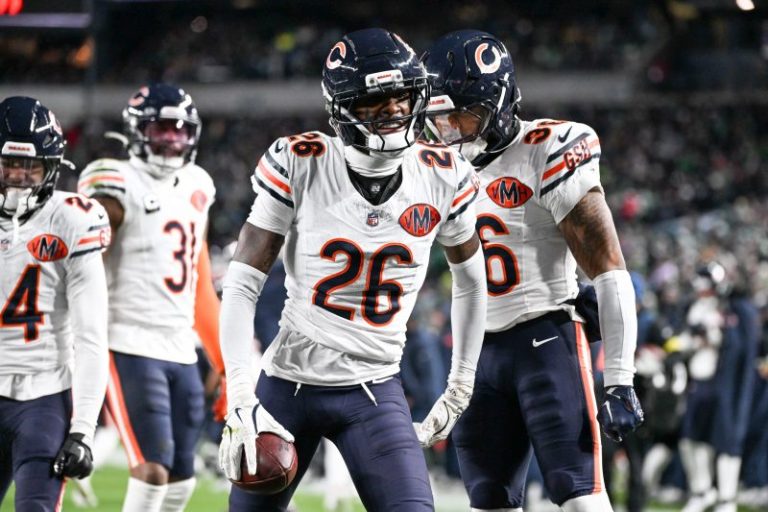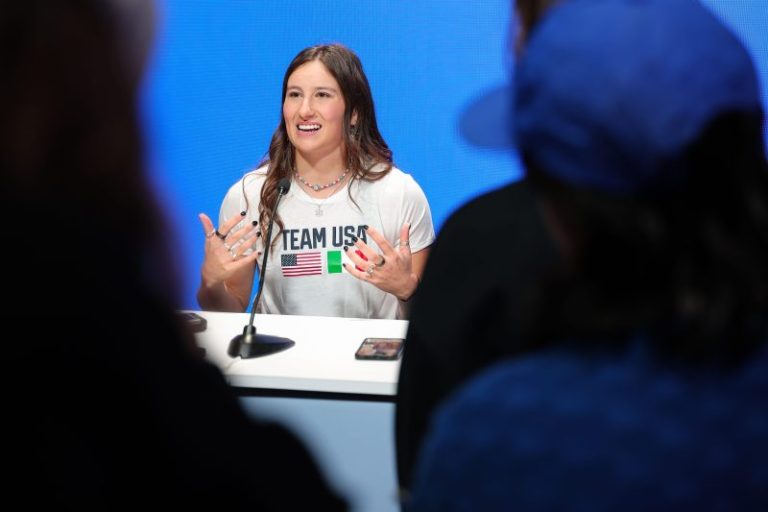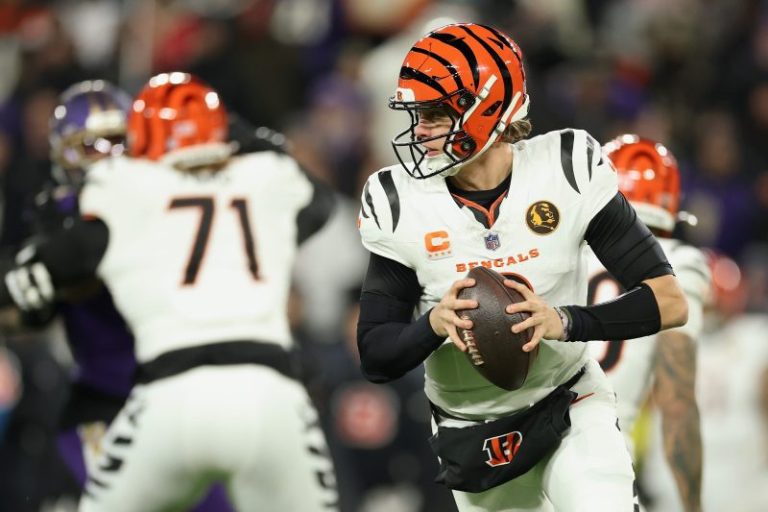The last time the Chicago Bears went to Philadelphia and beat the Eagles, quarterback Caleb Williams was a week away from his 10th birthday.
That run comes to an end as the Bears earned an emphatic 24-15 win over the defending champion Eagles on Black Friday at Lincoln Financial Field. Chicago entered the week as the second-best rushing offense in the league and looked the part all night with their first win in Philadelphia since Nov. 7, 2011.
Former Eagle D’Andre Swift followed tight end Cole Kmet past the line for the game’s first touchdown in the first quarter. The Philadelphia native enjoyed a standout performance with 18 carries for 125 yards and that score.
Chicago didn’t need to rely solely on Swift, though. Rookie running back Kyle Monangai had another standout game and finished the contest with 22 carries for 130 yards and a score as well.
Entering Week 13, the Eagles were averaging 115 rushing yards allowed per game. Chicago more than doubled that in a dominant display by Ben Johnson’s offense.
Despite those gaudy totals, the Eagles’ defense papered over their frustrating offense for much of the first half. Chicago out-gained Philadelphia 222 to 83 but only held a 10-7 lead at halftime.
Philadelphia forced two quick punts in the second half to neutralize a Jalen Hurts interception and a three-and-out. The Eagles then marched 92 yards for their first touchdown to make it 10-9 and the defense intercepted Williams on the ensuing drive.
But the game turned when Bears cornerback Nahshon Wright did something no other player has done this year: force a fumble on a tush push by Hurts, in the red zone no less.
Chicago capitalized on that turnover with Monangai’s touchdown to make it 17-9. A quick three-and-out by the Eagles gave the Bears’ offense the ball back with a chance to extend the lead and Williams found Kmet for a score to make it 24-9.
Philadelphia got on the board with a second touchdown from Hurts to A.J. Brown, but couldn’t cut the deficit to one score. Chicago earned a marquee victory over the defending champions to stay atop the NFC North standings.
The Bears (9-3) stay on the road next week for another tough test against the Green Bay Packers (8-3-1). Philadelphia (8-4) has lost two in a row for the second time this season and is on the road next week against the Los Angeles Chargers.
USA TODAY Sports provided updates, stats and highlights from the NFL Black Friday game below. All times are Eastern.
Eagles vs. Bears takeaways
Chicago’s run game is for real: There are few tougher tests for an interior offensive line than Philadelphia. Jalen Carter is a dominant force but the Bears’ interior consistently got a push and sealed off weak-side defenders to open up lanes for Swift and Monangai. Each back had their moments – Swift on the outside, Monangai between the tackles – in a defining game for the Bears’ offensive line.
Eagles’ defense still strong: For how lopsided the first half was, Philadelphia was lucky to be down by just seven points. The Eagles’ defense continued to bend but not break and tee off on Williams. Chicago’s passing offense was in a tough spot for much of the game. Vic Fangio’s unit shouldn’t take much blame for this result.
Tush push in trouble? In Week 8, Giants linebacker Kayvon Thibodeaux tried to force a fumble on Hurts during a tush push. Nahshon Wright did the same, but crucially did so before Hurts’ forward progress was stopped, giving the Bears the ball back on a huge swing play. This could be the first of many teams trying a similar strategy to neutralize the Eagles’ most popular play. It was a signature play for the Bears in an outstanding game for Dennis Allen’s unit.
Eagles’ offensive woes continue: Philadelphia was shut out in the second half last week in a loss to the Cowboys in Dallas. This week, the Eagles could only muster two first downs in the first half. Things improved in the second half, but not enough to keep them in contention, thanks to critical turnovers. If offensive coordinator Kevin Patullo’s seat was getting warm entering the holiday week, it’s red-hot now.
Jalen Hurts stats vs. Bears
19-of-34 (55.8% completion rate)
230 passing yards
2 passing touchdowns
1 interception
84.2 passer rating
4 rushing attempts
31 rushing yards
0 rushing touchdowns
Caleb Williams stats vs. Eagles
17-of-36 (47.2% completion rate)
154 passing yards
1 passing touchdown
1 interception
56.9 passer rating
5 rushing attempts
13 rushing yards
0 rushing touchdowns
D’Andre Swift stats vs. Eagles
18 rushing attempts
125 rushing yards
1 rushing touchdown
1 reception (2 targets)
13 receiving yards
0 receiving touchdowns
Kyle Monangai stats vs. Eagles
22 rushing attempts
130 rushing yards
1 rushing touchdown
0 receptions (1 target)
A.J. Brown stats vs. Bears
10 receptions (12 targets)
132 receiving yards
2 receiving touchdowns
Eagles vs. Bears highlights
Eagles vs. Bears Black Friday game final score: Bears 24, Eagles 15
Eagles’ Jake Elliott misses late FG
With time running out in the fourth quarter, Philadelphia brought out kicker Jake Elliott for a field goal to make it a one-score game. His kick leaned wide left from 52 yards out and Chicago will run the clock out.
Bears turnover on downs late in fourth quarter
Chicago opted to go for it on 4th and 4 from the Eagles’ 30-yard line with less than 80 seconds to play. Caleb Williams’ pass fell incomplete, and the Eagles take over with 1:12 to go in the game, down nine points.
Eagles vs. Bears score update: Jalen Hurts, A.J. Brown connect for another TD
Philadelphia answered the Bears’ fourth-quarter touchdown drive with one of their own. The Eagles marched 80 yards in 12 plays and took just over three minutes off the clock in the fourth quarter. Hurts capped things off by finding Brown once again for the duo’s second touchdown from 21 yards out.
Philadelphia opted to go for the two-point conversion now instead of later. Hurts’ pass to Saquon Barkley fell incomplete, which crucially keeps it a two-score game with 3:10 to go in the fourth quarter.
Bears 24, Eagles 15
Eagles vs. Bears score update: Caleb Williams finds Cole Kmet for TD
Facing second and 8 from the Eagles’ 28-yard line, Caleb Williams rolled to his left after faking a handoff to D’Andre Swift. Tight end Cole Kmet found room past the second level of the Eagles’ defense and outran safety Reed Blankenship to secure a deep shot from Williams for the score.
Cairo Santos’ extra point is good and Chicago extends its lead with 6:19 to go in the game.
Bears 24, Eagles 9
Bears defense forces another Eagles punt
After Chicago extended their lead in the fourth quarter, the Eagles’ offense couldn’t get anything going and went three-and-out. Another Philadelphia punt gives the Bears’ offense the ball back at the Chicago 37-yard line with 11:15 to go in the game.
Eagles vs. Bears score update: Kyle Monangai breaks through for TD
Chicago capitalized on Hurts’ fumble and relied on the running game once again to march the length of the field. This time, it was the rookie running back Monangai who charged through his blockers and into the end zone for the score. Cairo Santos’ extra point is good and Chicago takes its biggest lead of the game with 12:49 to go in the fourth quarter.
Bears 17, Eagles 9
End of 3rd quarter: Bears 10, Eagles 9
Chicago’s offense is driving into Philadelphia territory as the third quarter comes to a close. A key fourth-down conversion on a pass from Caleb Williams to Colston Loveland kept the drive alive as Chicago looks to score for the first time since midway through. the second quarter.
The Bears have the ball at the Eagles’ 21-yard line on 2nd and 1 to start the final frame.
Jalen Hurts fumbles tush push, Bears take over
Philadelphia lined up for their signature tush push on 3rd and 1 at the Chicago 12-yard line. Hurts pushed forward in the scrum which gave Bears cornerback Nahshon Wright a window to knock the ball loose and recover it.
Chicago’s offense takes over at its own 13-yard line.
Eagles intercept Caleb Williams’ screen pass
The Bears quarterback faked a handoff to running back Kyle Monangai before the rookie leaked out for a shallow screen pass. Eagles defensive lineman Jalyx Hunt recognized the play, waited for Williams to throw, batted the ball up and intercepted it. Philadelphia takes over on the Chicago 36-yard line.
Eagles vs. Bears score update: Hurts connects with A.J. Brown for TD
Philadelphia marched 92 yards in less than two minutes to finally get a touchdown on the board for the Eagles’ offense. Quarterback Jalen Hurts hit a deep shot on 1st and 10 to A.J. Brown down the left sideline and Brown made the catch for his second touchdown in as many games.
Jake Elliott missed the extra point and Chicago still holds a lead with 8:05 to go in the third quarter.
Bears 10, Eagles 9
Eagles force three-and-out and another Bears punt
Philadelphia’s defense stood tall after the Hurts interception. Pressure on Caleb Williams on 3rd and 3 forced an overthrow near Rome Odunze. Chicago settled for another punt, and Tory Taylor pinned the Philadelphia offense deep in its own territory. The Eagles’ offense takes over at their own 8-yard line with 9:59 to go in the third quarter.
Bears pick off Jalen Hurts, take over on offense
Bears safety Kevin Byard intercepted a Hurts pass in the area of Eagles wideout A.J. Brown. Both Brown and Darius Cooper were in the area when Hurts released the pass, and Byard made the play to give Chicago’s offense the ball back near midfield.
Bears punt after Caleb Williams can’t connect with Luther Burden
Williams fired a pass well past the first-down marker towards Burden but the rookie wide receiver lost his footing and couldn’t corral the ball. The ball fell incomplete on 3rd and 5 from the Bears’ 39 and Chicago punted for the second time today.
A 10-yard penalty backed them up before Tory Taylor’s punt went out of bounds at the Eagles’ 26-yard line. Philadelphia takes over with 12:20 to go in the third quarter.
Eagles punt again to open second half
Former Eagle C.J. Gardner-Johnson provided sticky coverage on Eagles tight end Dallas Goedert on 3rd and 9 with the Bears’ pass rush bearing down on Jalen Hurts. Hurts’ pass falls incomplete and the Eagles punt once again.
Chicago’s offense takes over at its own 24-yard line with 13:49 to go in the third quarter.
NFL Black Friday game score at halftime: Bears 10, Eagles 3
Chicago couldn’t capitalize on a late-half possession and take a 10-3 lead into halftime.
The Bears hold a seven-point lead but have dominated the first half. Philadelphia has just two first downs to Chicago’s 16 and the Bears out-gained the Eagles 222 to 83 over the first 30 minutes of game time. That advantage is mostly on the ground as Chicago’s racked up 142 rushing yards on 22 carries in the first half.
Philadelphia will receive the second-half kickoff.
A.J. Brown penalty dooms Eagles drive, Philadelphia punts again
Eagles’ wide receiver A.J. Brown got penalized for pushing off on Bears cornerback Jaylon Johnson on a 12-yard gain on 3rd and 9. That penalty backed Philadelphia up to 3rd and 19 from their own 26-yard line. Jalen Hurts extended the play to the right and found Will Shipley for 11 yards and the Eagles punted once again.
Chicago takes over with 1:43 to go in the first half.
Eagles’ defense steps up to force Bears’ first punt
Eagles linebacker Nolan Smith Jr. pressured Caleb Williams on 3rd and 10 and Jalen Carter got the Bears’ quarterback to the ground for the first sack of the game. The Bears’ offense had their shortest drive of the game (five plays, three yards) and Chicago punted for the first time.
Philadelphia’s offense takes over at its own 35-yard line with 2:47 to go in the first half.
Bears’ defense forces three-and-out
Philadelphia managed just seven yards on its third drive of the game. Jalen Hurts’ pass on 3rd and 3 fell incomplete, intended for Dallas Goedert, and the Eagles punted for the second time today.
The Bears’ offense takes over at their own 20-yard line with 4:59 to go in the first half.
Eagles vs. Bears score update: Chicago settles for Santos FG
The Bears’ run game powered another long drive as Chicago marched 68 yards in 15 plays. Quarterback Caleb Williams threw three incomplete passes in a row in the red zone, though, and the Bears settle for a 30-yard Cairo Santos field goal.
Chicago holds a seven-point lead with 6:44 left to go in the first half.
Bears 10, Eagles 3
Eagles vs. Bears score update: Jake Elliott FG gets Philadelphia on the board
The Eagles’ offense sputtered getting close to the red zone and Jalen Hurts’ throw to DeVonta Smith on 3rd and 8 from the Bears’ 26-yard line fell incomplete. Jake Elliott knocked through a kick from 44 yards out to ensure Philadelphia got on the board early in the second quarter.
The Eagles’ offense drove 39 yards in seven plays for their second drive of the game.
Bears 7, Eagles 3
End of 1st quarter: Bears 7, Eagles 0
D’Andre Swift’s three-yard touchdown run is the lone points on the board through the first 15 minutes of action from Lincoln Financial Field.
The Eagles’ offense has the ball and will face 3rd and 3 from their own 42-yard line to start the second quarter.
Eagles vs. Bears score update: D’Andre Swift breaks through for TD
Former Eagles running back D’Andre Swift took an inside handoff from the three-yard line and followed tight end Cole Kmet through a hole for the game’s first score. Cairo Santos’ extra point is good and Chicago takes a 7-0 lead with 1:31 to go in the first quarter.
The Bears drove 78 yards in 11 plays to take 5:26 off the clock. Chicago’s run game powered that drive with 64 rushing yards on seven carries between Swift and fellow running back Kyle Monangai.
Bears 7, Eagles 0
Eagles forced to punt on opening possession after Hurts’ incomplete pass
Philadelphia got a quick first down on a Jalen Hurts pass to A.J. Brown. But the offense managed just five yards over their next three plays, culminating in Hurts throwing the ball away while scrambling away from pressure on 3rd and 5.
The Eagles punted and the Bears’ offense takes over again at their own 22-yard line.
Eagles’ challenge succeeds, Bears turnover on downs
Upon review, Bears running back Kyle Monangai was ruled short of the line to gain on 4th and 1. Philadelphia’s offense takes over at its own 25-yard line.
Chicago went 42 yards in 11 plays and took nearly five and a half minutes off the game clock.
Eagles challenge ball spot on fourth down run
Chicago’s knocking on the door of the red zone and faced a 4th and 1 from the Eagles’ 24-yard line. Rookie running back Kyle Monangai took a handoff up the middle and referee Carl Cheffers marked him past the line to gain.
It looked close on the broadcast and Eagles coach Nick Sirianni challenged the ball spot.
Bears wins toss, opts to receive
Caleb Williams and the rest of the Chicago offense will start today’s game with the ball first at their own 35-yard line.
Eagles vs. Bears Black Friday game start time
Start time: 3 p.m. ET (2 p.m. CT)
Date: Friday, Nov. 28
The Eagles and Bears are set to kick off at 3 p.m. ET on Black Friday. Chicago will head to Lincoln Financial Field to take on Philadelphia.
Eagles vs. Bears TV channel
Live stream: Amazon Prime Video
Chicago market: WFLD (FOX 32) | Philadelphia market: WTXF (FOX 29)
The NFL Black Friday game will exclusively stream on Amazon Prime Video for national viewers. For those in the Eagles TV market, WTXF (FOX 29) will air the game. In Chicago, viewers can tune to WFLD (FOX 32).
Eagles vs. Bears live stream
Live stream: Amazon Prime Video
The Eagles-Bears Black Friday matchup will be available exclusively on Amazon Prime Video.
Stream the Black Friday game on Amazon Prime Video
Eagles vs. Bears predictions, picks
Here’s how the USA TODAY Sports staff feels the Eagles-Bears Black Friday game will shake out:
Jarrett Bell: Eagles 26, Bears 21
Nick Brinkerhoff: Eagles 28, Bears 24
Chris Bumbaca: Eagles 28, Bears 20
Nate Davis: Eagles 27, Bears 23
Tyler Dragon: Eagles 30, Bears 21
Michael Middlehurst-Schwartz: Eagles 27, Bears 24
Eagles vs. Bears odds
Provided by BetMGM Sportsbook; access USA TODAY Sports Scores and Sports Betting Odds hub for a full list. Lines last updated Wednesday at 9:20 a.m.
Moneyline (ML): Philadelphia -325 (Bet $325 to win $100) | Chicago +260 (Bet $100 to win $260)
Against the spread (ATS): Philadelphia -7 (-110) | Chicago +7 (-110)
Over/Under (O/U): 44.5 (O: -110 | U: -110)
4th & Monday: Our NFL newsletter always brings the blitz
Do you like football? Then you’ll enjoy receiving our NFL newsletter in your inbox.
Get the latest news, expert analysis, game insights and the must-see moments from the NFL conveniently delivered to your email inbox. Sign up now!
What time is the NFL Black Friday game today?
Start Time: 3 p.m. ET
Kickoff for the NFL’s Black Friday game is scheduled for 3 p.m. ET. It is the lone NFL game today.
Bears inactives vs. Eagles
Chicago is down three linebackers in its regular defensive rotation today when it faces Philadelphia.
QB Case Keenum
WR Jahdae Walker
CB Tyrique Stevenson
LB Noah Sewell
LB Ruben Hyppolite II
LB T.J. Edwards
DE Dominique Robinson
Eagles inactives vs. Bears
Philadelphia will be without its All-Pro right tackle, Lane Johnson, today when it faces Chicago.
RB A.J. Dillon
WR Xavier Gipson
QB Sam Howell (3rd QB)
T Lane Johnson
CB Mac McWilliams
DT Ty Robinson
OLB Joshua Uche
NFC East standings
The Eagles are in first place in the NFC East standings.
Philadelphia Eagles (8-3)
Dallas Cowboys (6-5-1)
Washington Commanders (3-8)
New York Giants (2-10)
NFC North standings
The Bears are in first place in the NFC North standings. Below is a look at the division standings after the Lions vs. Packers Thanksgiving game:
Chicago Bears (8-3)
Green Bay Packers (8-3-1)
Detroit Lions (7-5)
Minnesota Vikings (4-7)
NFC playoff picture
Los Angeles Rams (9-2; NFC West leaders)
Philadelphia Eagles (8-3; NFC East leaders)
Chicago Bears (8-3; NFC North leaders)
Tampa Bay Buccaneers (6-5; NFC South leaders)
Seattle Seahawks (8-3; wild card No. 1)
Green Bay Packers (8-3-1; wild card No. 2)
San Francisco 49ers (8-4; wild card No. 3)
In the hunt: Detroit Lions (7-5); Dallas Cowboys (6-5-1); Carolina Panthers (6-6); Atlanta Falcons (4-7); Minnesota Vikings (4-7); Arizona Cardinals (3-8); Washington Commanders (3-8); New Orleans Saints (2-9);
Eliminated: New York Giants (2-10).
Eagles vs. Bears injury report
Which NFL team has the most Super Bowl wins?
The Steelers are tied with the New England Patriots for the most Super Bowl wins with six.
Pittsburgh and Dallas have the unique distinction of playing each other more than any other team combination in Super Bowl history with three matchups.
Who are the announcers for Amazon Prime Video’s Black Friday game?
Al Michaels (play-by-play) and Kirk Herbstreit (analyst) will be in the broadcast booth for Prime Video, with Kaylee Hartung (sideline) and Terry McAulay (rules analyst) providing additional coverage.
The Prime Video pregame, halftime and postgame shows feature Charissa Thompson as host, as well as former NFL players Ryan Fitzpatrick, Tony Gonzalez, Richard Sherman and Andrew Whitworth as analysts.
How old is Al Michaels?
Michaels, who is once again serving as the play-by-play voice of Amazon Prime’s ‘Thursday Night Football,’ is 81. He turned 81 on November 12 and has worked on network sports television since 1971.
NFL final scores for Thanksgiving games
Thursday, Nov. 28
Green Bay Packers 31, Detroit Lions 24
Dallas Cowboys 31, Chiefs 28
Cincinnati Bengals 32, Ravens 14
This post appeared first on USA TODAY

